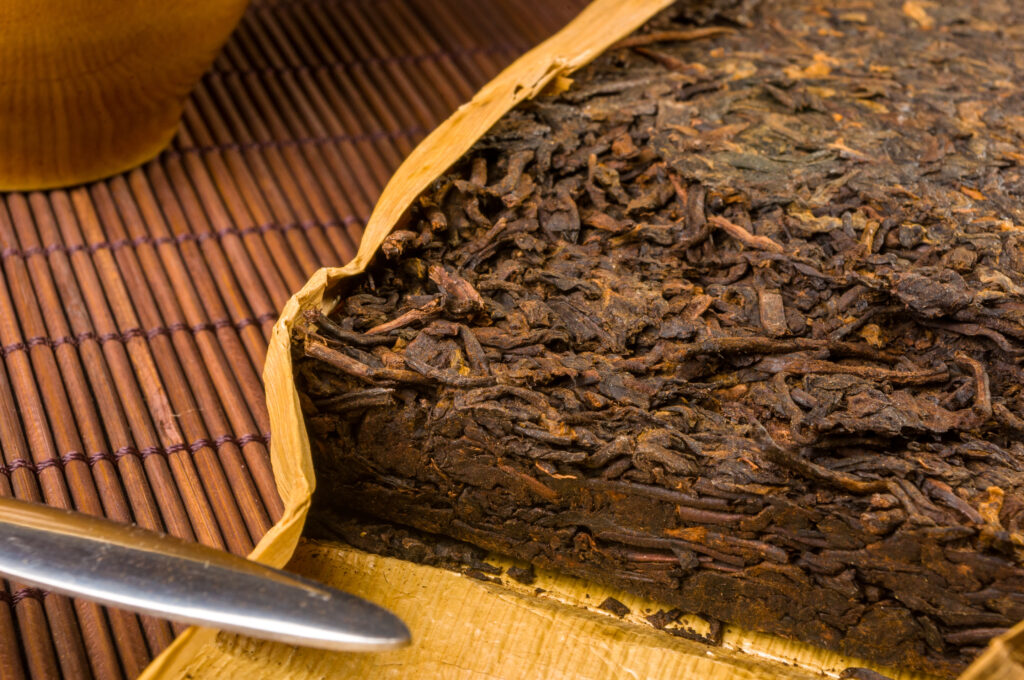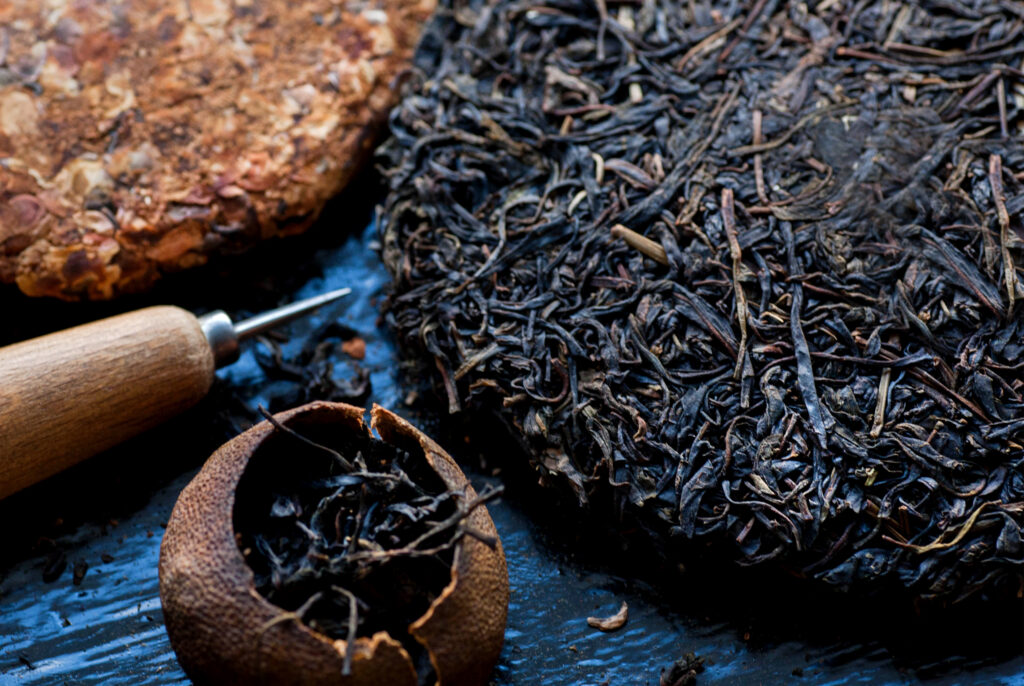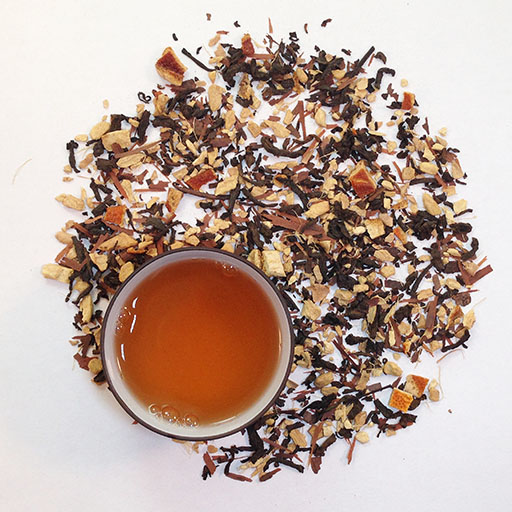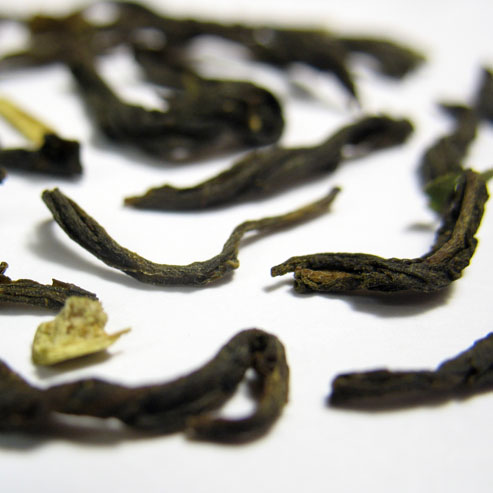China’s Fermented Tea, Puerh, a Boon for Digestion, Weight, Overall Health
People across Asia and around the world drink tea for flavor, energy, mental clarity and more. Sipping a cup of Earl Grey, Dragon Well Superior or any other style of tea serves as a ritual for many, too. It plays a role in rising from slumber, powering across a busy afternoon and punctuating the end of a day.
But for many, tea represents much more than a habit, flavor experience or energy boost. In addition to all of the above, it’s viewed as a health tonic. Green tea receives a lot of press for its health benefits. Styles like black and oolong, as we have learned in this wellness series, also rank as stout health boosters. But perhaps no tea—at least in China—garners as much devotion for health as puerh, the only of the main styles of tea that is fermented.
We so value puerh for both flavor and health that we included a puerh in our Wellness Tea Box.
What is puerh?
Like all traditional teas, puerh starts out as leaves from the Camellia sinensis plant, which is native to China and Southeast Asia. The process that divides green from white, black and oolong teas revolves mostly around oxidation. An abundance of exposure to oxygen is what turns fresh green tea leaves into black tea, for example. But with puerh a different factor—fermentation—separates it from the other styles. And fermentation explains puerh’s unique and compelling flavors, and some of its health advantages.

Styles of puerh tea
Tea artisans who craft puerh use different methods to create their beautiful teas. Both approaches lean into fermentation, but they diverge from each other in the particulars. In both cases, they essentially begin as green teas—just-harvested leaves that experience halted oxidation, normally through roasting. But where the process to make green tea ends with roasting, with puerh it’s just getting started.
Sheng or “raw” puerhs typically get pressed into discs and aged for 10 or more years before tea masters consider them ready for sipping. As the tea ages, fermentation continues to affect flavor and health attributes. However, not all raw puerhs need to be aged for a decade to be delicious. Most raw puerhs broadcast vegetal, grassy notes with hints of camphor and even stone fruits.
Shu or “ripe” puerhs undergo a sped up fermentation process. Tea artisans apply a “piling” process to ripe puerhs, which encourages bold fermentation. Ripes often taste profoundly earthy, with hints of mushroom, tobacco and forest floor.
Both styles are widely manufactured in China’s southern Yunnan Province, as well as in Taiwan. The processes yield variations in flavor, but most puerhs do share some similarities—most notably earthiness.
Puerh health benefits

Weight loss
The attribute that sets puerh apart—fermentation—contributes toward its health benefits. For example, as puerh is a fermented tea, it contains probiotics, which are healthy gut bacteria involved in different aspects of maintaining human vigor. One potential upside? Improved control over blood sugar, which plays an important role in weight management. A study of overweight people, for example, found that participants who consumed puerh extract every day experienced “significant weight loss, reduced body mass index and an improved lipid profile.”
Improve cholesterol
One study submitted that puerh tea is considered healthy because it serves as “a natural source of cardioprotective lipid lowering and antioxidant compounds.” To interrogate puerh tea’s effects on cholesterol, the study analyzed how the tea interacted with cholesterol in rats. The conclusion? “Our results suggest that puerh tea exerts strong antioxidative and lipid-lowering effects and therefore can be used to reduce the risk of cardiovascular disorders.” Among other things, fermentation precipitates the development of lovastatin in puerh, a natural compound that gets tapped by pharmaceuticals to lower cholesterol.
Aiding digestion

Digestion optimization ranks as a principal reason for such puerh adoration among people in China. It is widely consumed to settle stomachs and ensure that food is full digested. Post-prandial puerh consumption, especially after heavy meals, is commonplace. But puerh’s connection to digestion goes beyond tradition. Research shows that compounds in puerh tea help dismantle fats, while also bolstering the gut’s balance of healthy bacteria.
The list of studies exploring links between puerh and health is lengthy. We appreciate that puerh offers sippers medical benefits—without the side-effects and expense that comes with pharmaceuticals. Even better, it tastes absolutely delicious, and is collected by tea aficionados around the world. How’s that for medicine! Effective and delicious!
Puerh Tea for Wellness: Tangerine Puerh

Health benefits have long driven interest in this style of tea, from Xin Hui in China’s southern Guangdong Province—we like it so much that it’s the puerh tea in our Wellness Box. Tea artisans in the region stuff hollowed tangerine rinds with fermented puerh tea, and let them age further before distributing them. People crack open the tangerines and pour the tea leaves into pots for brewing—often with pieces of rind. People across China swear by the wellness advantages of tangerine puerh. It’s got Sheng Jin (making your mouth feel quenched), Run Fei Zhi Ki (suppressing coughs and nurturing lung performance) and Qu Re (reducing internal heat). It tastes wonderful, too—the subtle citrus notes are winning.
Puerh Tea for Wellness: Ginger Puerh

We know that puerh already delivers profound wellness boosts. So why not combine it with other healthy botanicals? This healthy gem blends ripe puerh with ginger, orange peel and lapacho, a South American herb widely used for health purposes. As such, this detoxing tea represents a marriage between Eastern and Western botanical wisdom traditions. The ginger, which is widely known for aiding digestion, adds a pleasing heat to the blend. The lapacho offers woodsy, herbal qualities. The orange peel punches up the brew with citrus and the ripe puerh contributes its signature flavors and fermented health benefits.
Puerh Tea for Wellness: Sweet Rice Raw Puerh

Japanese genmaicha combines green sencha tea with brown rice, a blend that helps reduce caffeine in the brew while also adding rich flavor. We love it, and we also embrace this lesser-known variation. The healthy raw puerh lends its grassy, herbal notes to the elixir. Meanwhile, the rice contributes a sweet depth. The simultaneously earthy and cooling combination, crafted by Hmong people in the small town of Pingbian in southern Yunnan Province, will leave you refreshed and energized.

